Feasibility Study of a Piezo Actuator as a Potential Standard in Calibration for Roundness Instruments
Abstract
1. Introduction
2. Materials and Methods
2.1. Measurement Setup
- (a)
- InterferometerTo perform the experiments the XL-80 interferometer system (Renishaw, Wotton-under-Edge, UK) was used (accuracy: ppm, linear resolution: 1 nm) along with the Renishaw small optics kit (A-8003-3244), which includes a lightweight retroreflector. The schematic view of the setup is presented in Figure 2 and the photograph of the whole set with piezo actuator is in Figure 3.The interferometer was selected to work in the linear dynamic mode to collect the data while the position of the piezo actuator was changing dynamically. A relatively high sampling rate (50 kS/s) was chosen, as the acquired data were aimed to be used to characterise the response of the piezo actuator, besides the calibration of the device itself.
- (b)
- Roundness instrumentThe Taylor Hobson 130 (Leicester, UK) roundness measurement instrument was used as a device to be calibrated with a standard based on a piezo actuator. The resolution declared by the manufacturer, used when component deviations are less than 0.40 mm, is 6 nm. The Ultra® (Taylor Hobson) software was used to collect the data. Further details can be found in [30]. The configuration of the device, while carrying out the experiments, was different than usually used when working with roundness-measurement instruments. The piezo actuator was located outside the turntable and the probe of the roundness instrument was oriented horizontally, using possible movements of the arm and the column of the instrument. The tip of the probe was touching the surface of the gauge block mounted to the piezo actuator (Figure 4).
- (c)
- Piezo actuatorFor the experiments, the LPS710M (Thorlabs, Newton, NJ, USA) piezo actuator was used (Figure 4). All the tests were performed in a closed-loop configuration available for the actuator. For the closed-loop operation key specifications declared by the manufacturer are as follows: resolution: 6 nm, accuracy: ±0.06%, bidirectional repeatability: ±0.03%, angular error: rad, maximum load: 300 g, displacement range: 800 m—the detailed specification can be found in [31]. A small holder (custom-made) was screwed to the top surface of the actuator and the gauge block (to put the touching probe on the clean, flat, with-little-roughness surface) or retroreflector was fixed to the holder while working with the roundness measurement machine or the interferometer, respectively. The movement of the piezo actuator was programmed with Kinesis® (Thorlabs) software. The actuator was driven by a dedicated Thorlabs PPC001 Piezo Controller. Key parameters of the driver—drive voltage stability: 100 ppm over 24 h, drive voltage noise: <0.5 mV RMS (20 Hz–100 kHz)—further details can be found in [31].
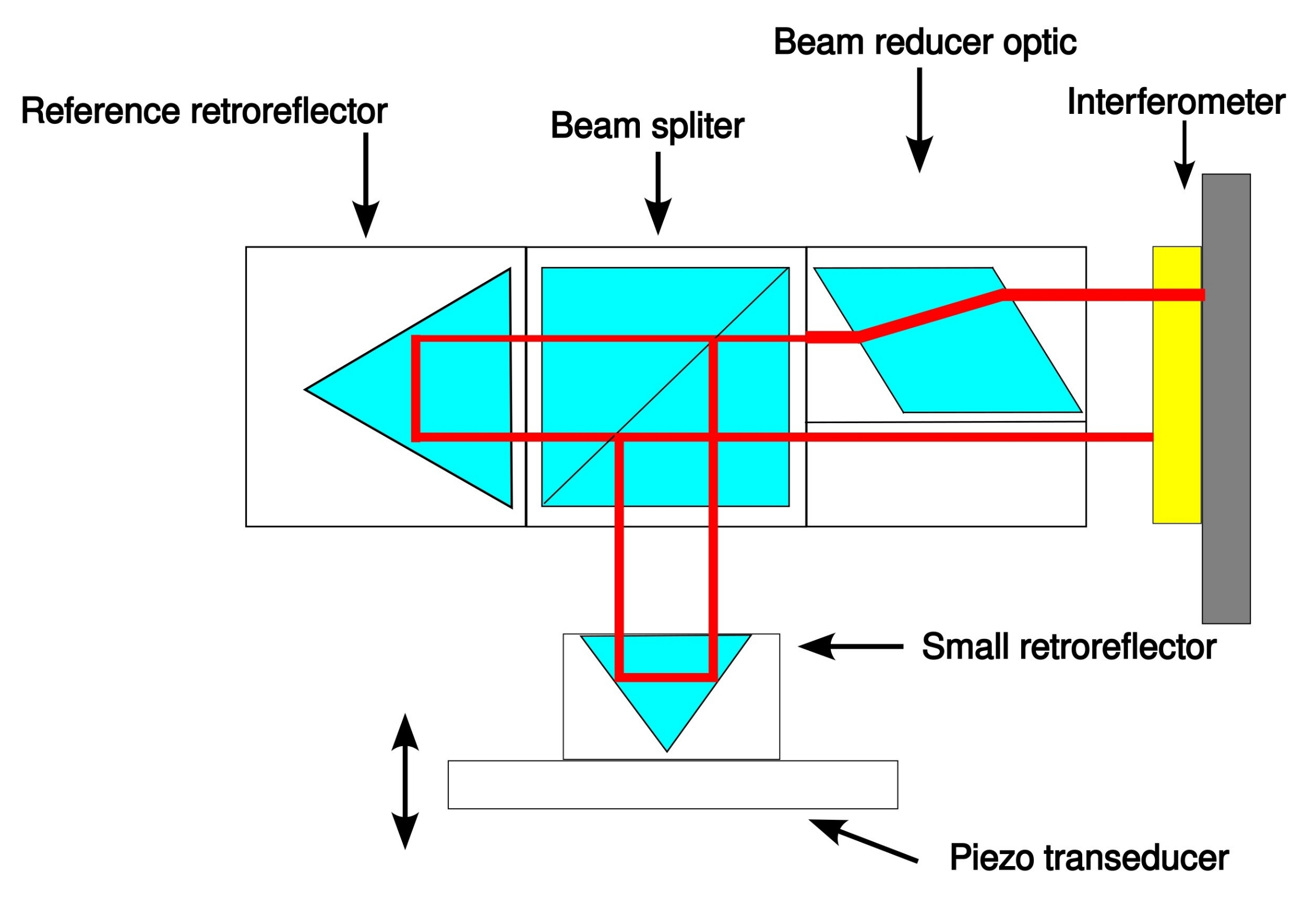
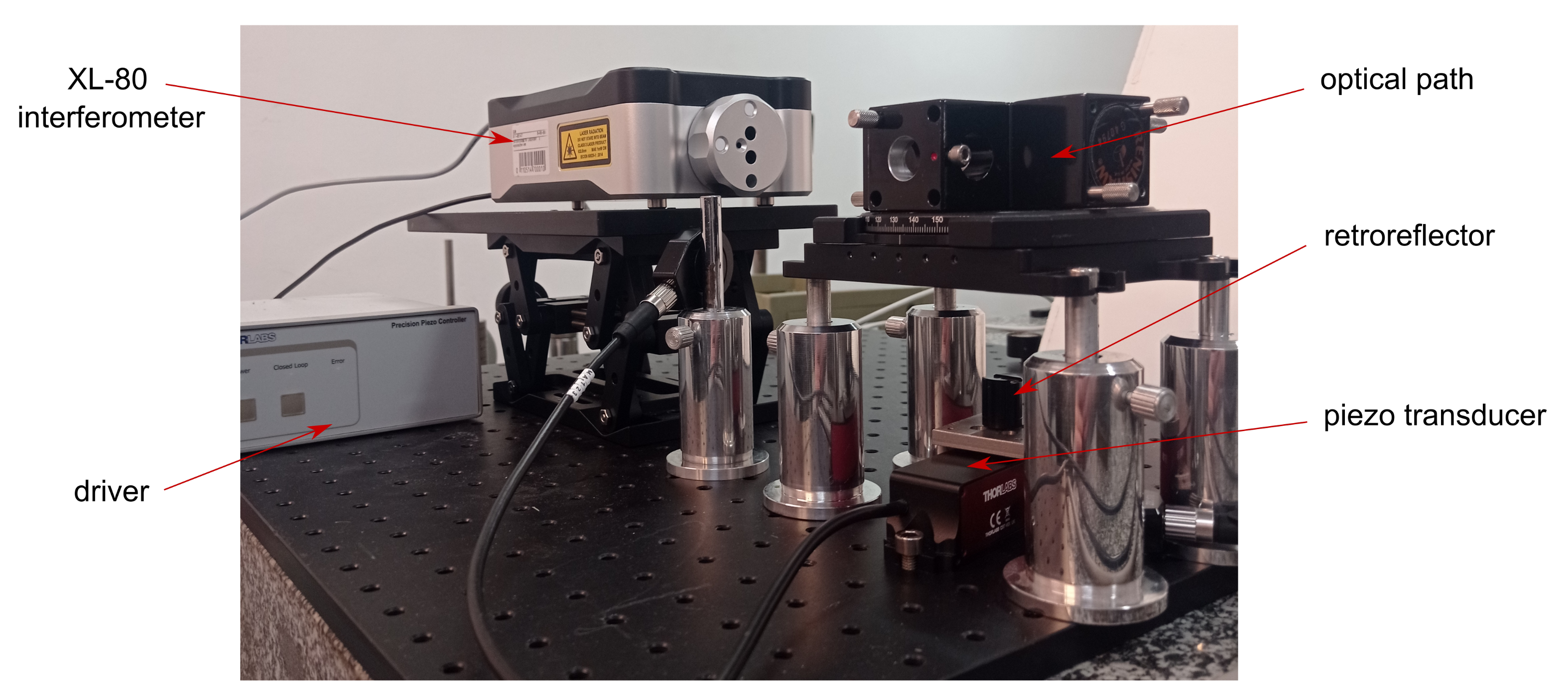

2.2. Methodology
2.3. Data Collecting Procedure
- (a)
- Interferometer dataThe calibration of the piezo actuator, performed with an XL-80 interferometer (Figure 2 and Figure 3) involved measurements of six grooves’ depths (as mentioned above). For each depth, two 40 s acquisitions were performed with a sampling rate of 50 kS/s (Laser XL system’s software, dynamic linear option, Renishaw). The initial position of the actuator was 100 m, which is of the device range. The actuator position was decreased for 1.5 s by a distance equal to the desired groove depth, then it returned to the initial position and after 3 s of break, the pattern was repeated. This resulted in 8 repetitions per single acquisition, 16 repetitions per each depth (two measurement series). Original data were stored within a binary block inside 12 Renishaw ‘.rtx’ files (six depths, two files per each depth), represented as double-precision floating-point numbers.
- (b)
- Taylor Hobson dataThe calibration of the Taylor Hobson 130 roundness measurement machine, based on the piezo actuator, involved the simulation of the same grooves’ depths as in the case of calibration of the actuator with the XL-80 interferometer. Data were collected in the same way as when performing typical roundness measurements, but with a different arm position and with the reference standard located out of the turntable. The acquisition time was determined by the speed of the machine’s turntable, which was 6 RPM. One full revolution of the turntable took 10 s and that was the acquisition time. The sampling frequency was equal to 360 S/s. The measurements were performed without an external synchronisation between the piezo actuator controller and the measurement machine. Assuming that the actuator motion pattern consists of 1 s wide groove and 4 s of break performed periodically, two grooves may appear in the data. Out of them, one will meet conditions regarding the required data length before and after the groove, and the second may meet this requirement or may not. This way, even without synchronisation between devices at least one valid measurement was always achieved. For each depth 2 series of 15 measurements were performed. Data were stored in binary format inside Taylor Hobson ’.SBF’ files, represented as double-precision floating-point numbers. This resulted in 30 files per depth, 180 files in total.
2.4. Data Processing
2.4.1. Estimation of Grooves’ Parameters
2.4.2. Data Validation
2.4.3. Overshot, Undershot and Settling Time Calculations
3. Results
3.1. Calibration of the Piezo Actuator with the Laser Interferometer
3.2. Uncertainty Budget for Interferometer Measurement of the Piezo Actuator
3.3. Calibration of the Roundness Measurement Machine with the Piezo Actuator
3.4. Uncertainty Budget for Roundness Instrument
4. Discussion
4.1. Limitations of the Method
4.2. Prospects of the Method
5. Conclusions
Author Contributions
Funding
Data Availability Statement
Conflicts of Interest
References
- Estler, W.T.; Phillips, S.D.; Borchardt, B.; Hopp, T.; Witzgall, C.; Levenson, M.; Eberhardt, K.; McClain, M.; Shen, Y.; Zhang, X. Error compensation for CMM touch trigger probes. Precis. Eng. 1996, 19, 85–97. [Google Scholar] [CrossRef]
- Küng, A.; Meli, F.; Thalmann, R. Ultraprecision micro-CMM using a low force 3D touch probe. Meas. Sci. Technol. 2007, 18, 319. [Google Scholar] [CrossRef]
- Fan, K.C.; Cheng, F.; Wang, W.; Chen, Y.; Lin, J.Y. A scanning contact probe for a micro-coordinate measuring machine (CMM). Meas. Sci. Technol. 2010, 21, 054002. [Google Scholar] [CrossRef]
- Matsukuma, H.; Wen, B.; Osawa, S.; Sekine, S.; Shimizu, Y.; Gao, W. Design and construction of a low-force stylus probe for on-machine tool cutting edge measurement. Nanomanuf. Metrol. 2020, 3, 282–291. [Google Scholar] [CrossRef]
- Thalmann, R.; Brouwer, D.M.; Haitjema, H.; Schellekens, P.H. Novel design of a one-dimensional measurement probe. Proc. Recent Dev. Traceable Dimens. Meas. SPIE 2001, 4401, 168–174. [Google Scholar] [CrossRef]
- Fan, K.C.; Li, R.J.; Xu, P. Design and verification of micro/nano-probes for coordinate measuring machines. Nanomanufacturing Metrol. 2019, 2, 1–15. [Google Scholar] [CrossRef]
- Emerson Iv, R.; Camesano, T. On the importance of precise calibration techniques for an atomic force microscope. Ultramicroscopy 2006, 106, 413–422. [Google Scholar] [CrossRef]
- Naftaly, M. Metrology Issues and Solutions in THz Time-Domain Spectroscopy: Noise, Errors, Calibration. IEEE Sens. J. 2013, 13, 8–17. [Google Scholar] [CrossRef]
- Dai, G.; Koenders, L.; Fluegge, J.; Bosse, H. Two approaches for realizing traceability in nanoscale dimensional metrology. Opt. Eng. 2016, 55, 091407. [Google Scholar] [CrossRef]
- Trapet, E.; Savio, E.; De Chiffre, L. New advances in traceability of CMMs for almost the entire range of industrial dimensional metrology needs. Cirp Ann. 2004, 53, 433–438. [Google Scholar] [CrossRef]
- Larrabee, R.D.; Postek, M.T. Precision, accuracy, uncertainty and traceability and their application to submicrometer dimensional metrology. Solid State Electron. 1993, 36, 673–684. [Google Scholar] [CrossRef]
- Bosse, H.; Lüdicke, F.; Reimann, H. An intercomparison on roundness and form measurement. Measurement 1994, 13, 107–117. [Google Scholar] [CrossRef]
- Jusko, O.; Lüdicke, F. Novel multi-wave standards for the calibration of form measuring instruments. Proc. 1st Euspen Brem. 1999, 2, 299–302. [Google Scholar]
- Exploring Roundness, a Fundamental Guide to the Measurement of Cylindrical Form. 2011. Available online: https://www.taylor-hobson.com.cn/-/media/ametektaylorhobson/files/learning-zone/chinese/books/exploring-roundness.pdf?dmc=1&la=zh-cn&hash=2BC88FB7D1F6C7EA3B1BE60C64E7783D (accessed on 31 October 2022).
- Aldous, C.; Leroux, I.; Eves, B. High-accuracy roundness measurements at NRC. Meas. Sci. Technol. 2018, 29, 125006. [Google Scholar] [CrossRef]
- Baršić, G.; Šimunović, V. 18RPT01 Probe Trace Traceability for contact probe and stylus instrument measurements. In Proceedings of the 16th International Conference, Brijuni, Croatia, 22 October 2021. [Google Scholar]
- Ali, S.H.; Naeim, I.H. Surface imperfection and wringing thickness in uncertainty estimation of end standards calibration. Opt. Lasers Eng. 2014, 60, 25–31. [Google Scholar] [CrossRef]
- Prieto, E.; Arce, A.; Muñoz, R.; Trych-Wildner, A.; Al-Kahtani, F.; Saraiva, F.; Ślusarski, Ł.; Aksulu, M.; Zelenika, S.; Yandayan, T.; et al. A Report on the State of the Art for Calibration of Form Measurement Probes, EMPIR 18RPT01 Probe Trace; Zenodo, 2022. [CrossRef]
- Wiśniewska, M.; Żebrowska-Łucyk, S. Determination of form measuring machine displacement sensor characteristics with a use of flick standard. In Proceedings of the XXI IMEKO World Congress, Prague, Czech Republic, 30 August–4 September 2015; pp. 1575–1579. [Google Scholar]
- Nouira, H.; Bourdet, P. Evaluation of roundness error using a new method based on a small displacement screw. Meas. Sci. Technol. 2014, 25, 044012. [Google Scholar] [CrossRef]
- Widmaier, T.; Kuosmanen, P.; Hemming, B.; Esala, V.P.; Brabandt, D.; Haikio, J. New material standards for traceability of roundness measurements of large-scale rotors. In Proceedings of the 58th IWK, Ilmenau Scientific Colloquium Technische Universität, Ilmenau, Germany, 8–12 September 2014; pp. 8–12. [Google Scholar]
- Thalmann, R.; Spiller, J.; Küng, A.; Jusko, O. Calibration of Flick standards. Meas. Sci. Technol. 2012, 23, 094008. [Google Scholar] [CrossRef]
- Haitjema, H.; Kotte, G. Dynamic Probe Calibration using Laser Interferometry. Appl. Opt 1995, 34, 106–117. [Google Scholar]
- Haitjema, H. Traceable dynamic calibration of probes of roundness and roughness testers in the nanometric region using a digital piezo transducer. In Proceedings of the National Conference of Standards Laboratories, Baltimore, MA, USA, 10–13 October 1995; pp. 303–312. [Google Scholar]
- Liang, R.; Jusko, O.; Lüdicke, F.; Neugebauer, M. A novel piezo vibration platform for probe dynamic performance calibration. Meas. Sci. Technol. 2001, 12, 1509. [Google Scholar] [CrossRef]
- Haitjema, H. Dynamic probe calibration in the μm region with nanometric accuracy. Precis. Eng. 1996, 19, 98–104. [Google Scholar] [CrossRef]
- Haitjema, H.; Kotte, G. Dynamic probe calibration up to 10 kHz using laser interferometry. Measurement 1997, 21, 107–111. [Google Scholar] [CrossRef][Green Version]
- Haitjema, H. The calibration of displacement sensors. Sensors 2020, 20, 584. [Google Scholar] [CrossRef] [PubMed]
- Leach, R.K.; Cross, N. Low-cost traceable dynamic calibration of surface texture measuring instruments. Meas. Sci. Technol. 2001, 13, N1. [Google Scholar] [CrossRef]
- Talyrond 130 Specifications. Available online: https://www.taylor-hobson.com/products/roundness-form/shop-floor-roundness/talyrond-130. (accessed on 31 October 2022).
- Thorlabs LPS710M Piezo Actuator Specifications. Available online: https://www.thorlabs.com/newgrouppage9.cfm?objectgroup_id=11246. (accessed on 31 October 2022).
- ISO 5436-1:2000; Geometrical Product Specifications (GPS)–Surface Texture: Profile Method; Measurement Standards–Part 1: Material Measures. International Organization for Standardization: Geneva, Switzerland, 2000.
- Boensch, G.; Potulski, E. Measurement of the refractive index of air and comparison with modified Edlen’s formulae. Metrologia 1998, 35, 133–139. [Google Scholar] [CrossRef]

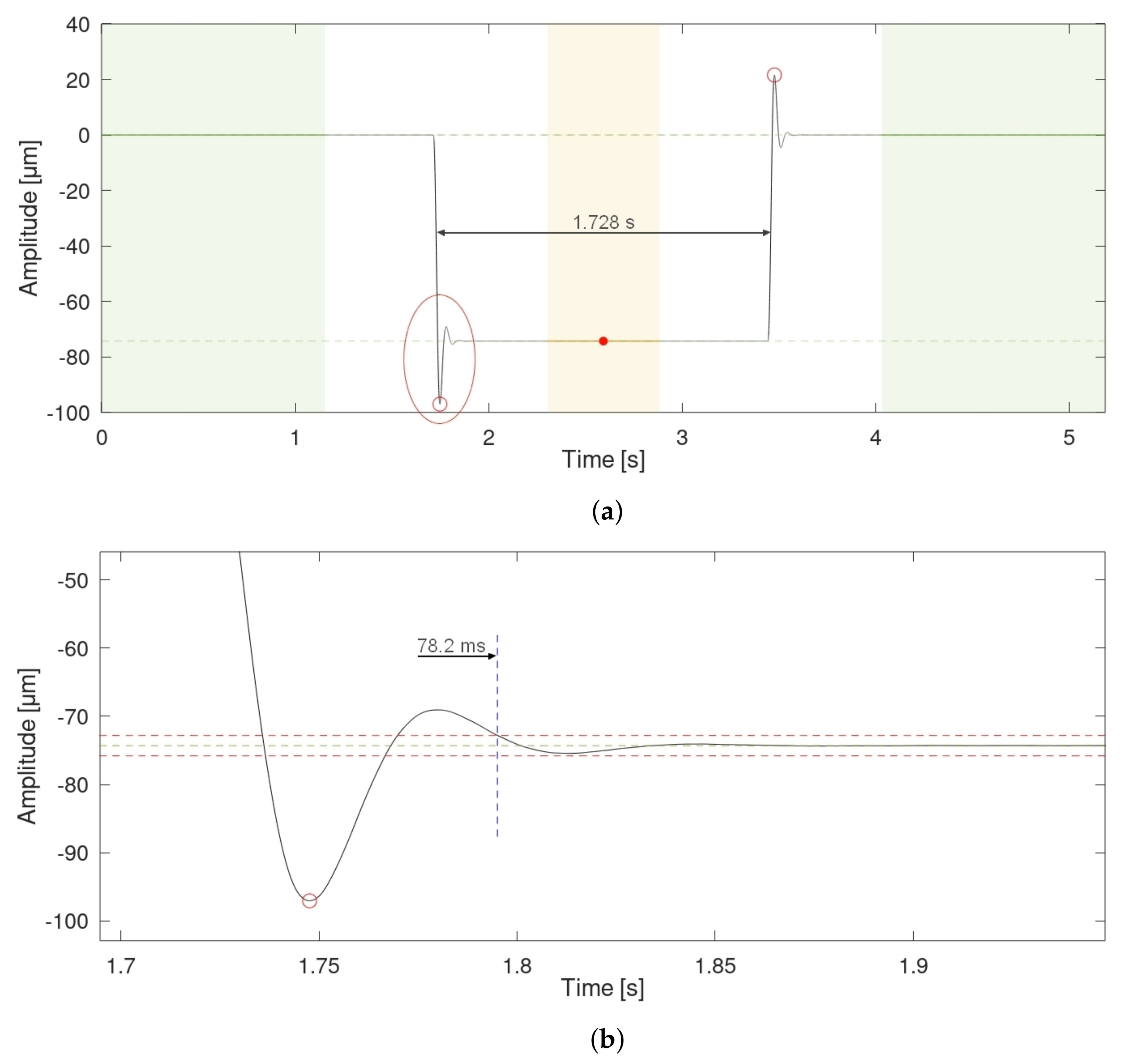
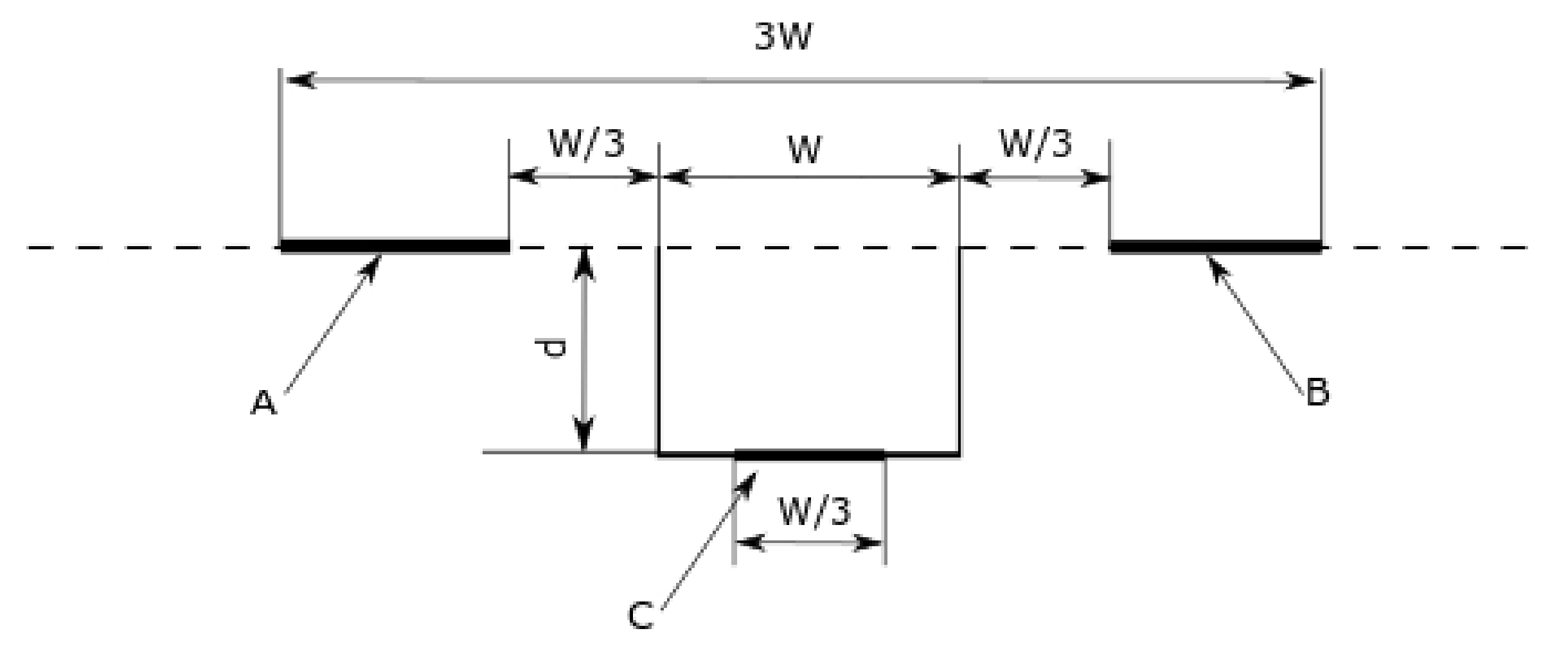

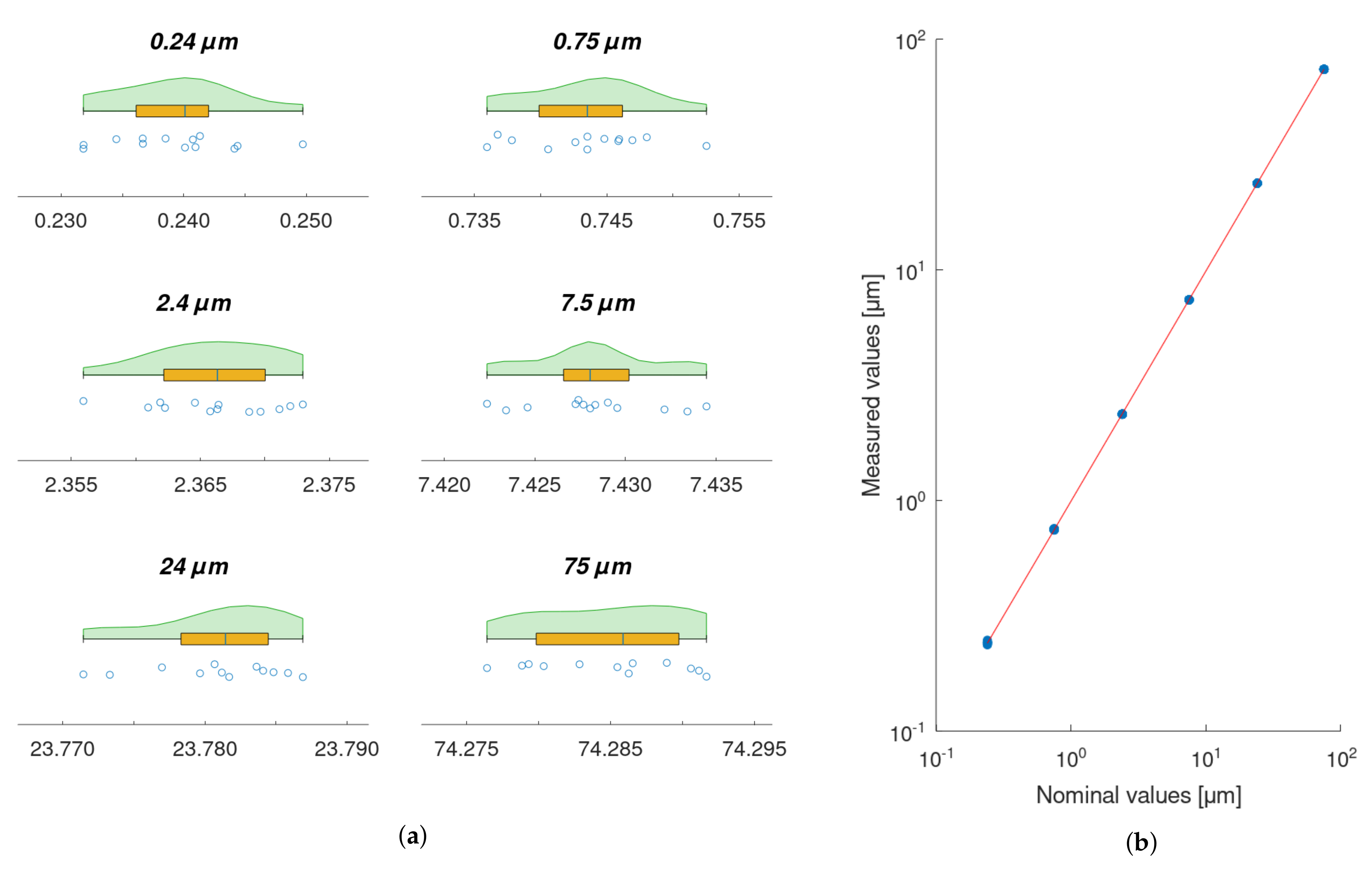



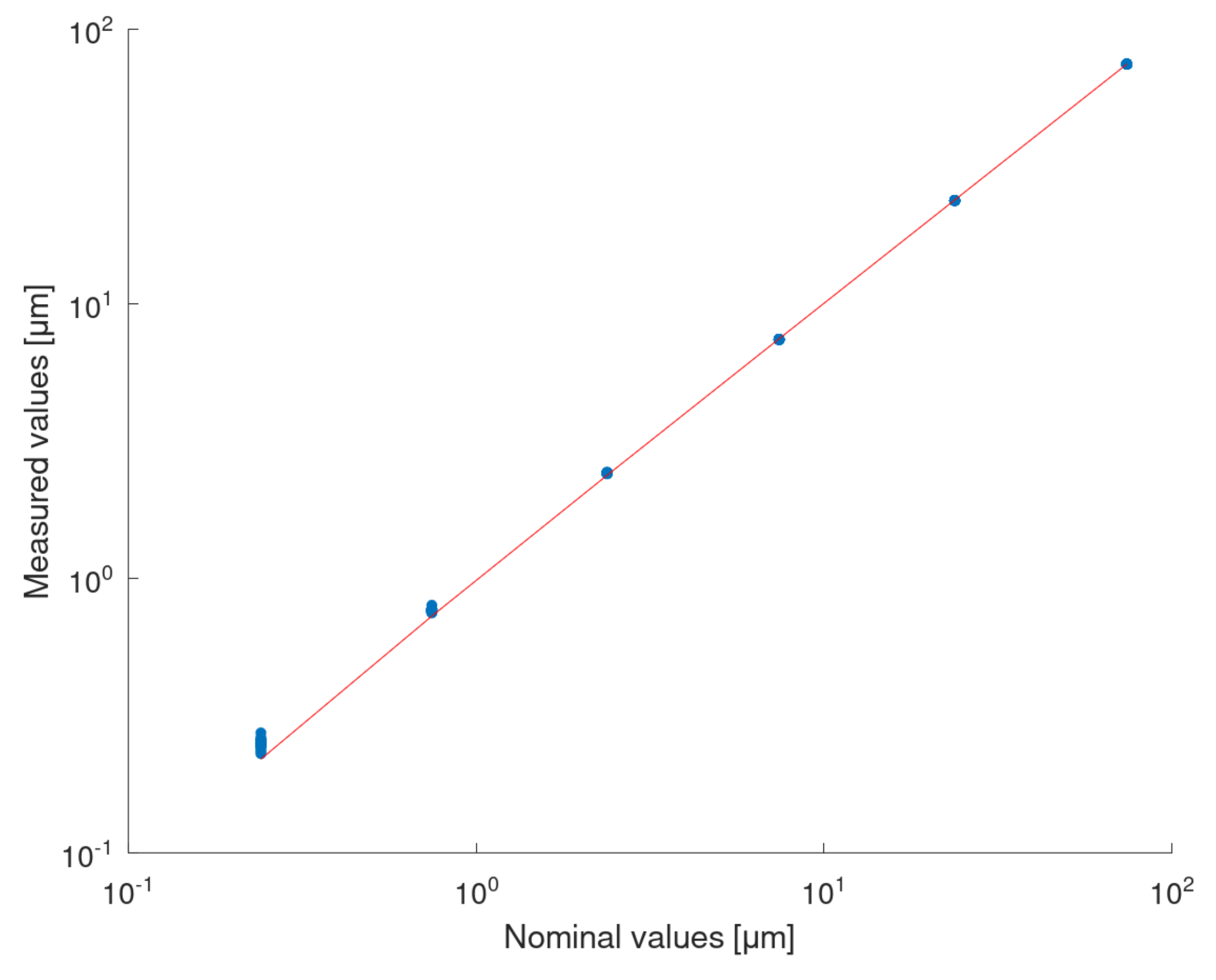

| Quantity | Uncertainty Contribution nm |
|---|---|
| Repeatability | for each groove nm * |
| Interferometer | 0.3 |
| Piezo actuator | 1.7 |
| Laser wavelength in air | 0.1 |
| Index of refraction | negligible |
| Interferometer nonlinearity | 2.3 |
| Thermal factors | 0.1 |
| Dead-path error | 5.1 |
| Abbé error | 5.8 |
| Cosine error | 0.1 |
| Quantity | Uncertainty Contribution in nm |
|---|---|
| Instrument resolution | 4 |
| Uncertainty of determining the depth of the groove (from simulated grooves) | 17 to 19 |
| Groove measurement repeatability | for each groove nm * |
Publisher’s Note: MDPI stays neutral with regard to jurisdictional claims in published maps and institutional affiliations. |
© 2022 by the authors. Licensee MDPI, Basel, Switzerland. This article is an open access article distributed under the terms and conditions of the Creative Commons Attribution (CC BY) license (https://creativecommons.org/licenses/by/4.0/).
Share and Cite
Trych-Wildner, A.; Wildner, K.; Sosinowski, P. Feasibility Study of a Piezo Actuator as a Potential Standard in Calibration for Roundness Instruments. Sensors 2022, 22, 9312. https://doi.org/10.3390/s22239312
Trych-Wildner A, Wildner K, Sosinowski P. Feasibility Study of a Piezo Actuator as a Potential Standard in Calibration for Roundness Instruments. Sensors. 2022; 22(23):9312. https://doi.org/10.3390/s22239312
Chicago/Turabian StyleTrych-Wildner, Anna, Krzysztof Wildner, and Piotr Sosinowski. 2022. "Feasibility Study of a Piezo Actuator as a Potential Standard in Calibration for Roundness Instruments" Sensors 22, no. 23: 9312. https://doi.org/10.3390/s22239312
APA StyleTrych-Wildner, A., Wildner, K., & Sosinowski, P. (2022). Feasibility Study of a Piezo Actuator as a Potential Standard in Calibration for Roundness Instruments. Sensors, 22(23), 9312. https://doi.org/10.3390/s22239312






